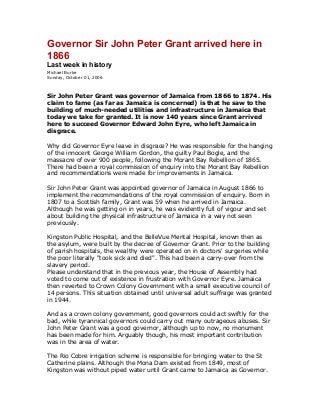
Governor sir john peter grant arrived here in 1866
- 1. Governor Sir John Peter Grant arrived here in 1866 Last week in history Michael Burke Sunday, October 01, 2006 Sir John Peter Grant was governor of Jamaica from 1866 to 1874. His claim to fame (as far as Jamaica is concerned) is that he saw to the building of much-needed utilities and infrastructure in Jamaica that today we take for granted. It is now 140 years since Grant arrived here to succeed Governor Edward John Eyre, who left Jamaica in disgrace. Why did Governor Eyre leave in disgrace? He was responsible for the hanging of the innocent George William Gordon, the guilty Paul Bogle, and the massacre of over 900 people, following the Morant Bay Rebellion of 1865. There had been a royal commission of enquiry into the Morant Bay Rebellion and recommendations were made for improvements in Jamaica. Sir John Peter Grant was appointed governor of Jamaica in August 1866 to implement the recommendations of the royal commission of enquiry. Born in 1807 to a Scottish family, Grant was 59 when he arrived in Jamaica. Although he was getting on in years, he was evidently full of vigour and set about building the physical infrastructure of Jamaica in a way not seen previously. Kingston Public Hospital, and the BelleVue Mental Hospital, known then as the asylum, were built by the decree of Governor Grant. Prior to the building of parish hospitals, the wealthy were operated on in doctors' surgeries while the poor literally "took sick and died". This had been a carry-over from the slavery period. Please understand that in the previous year, the House of Assembly had voted to come out of existence in frustration with Governor Eyre. Jamaica then reverted to Crown Colony Government with a small executive council of 14 persons. This situation obtained until universal adult suffrage was granted in 1944. And as a crown colony government, good governors could act swiftly for the bad, while tyrannical governors could carry out many outrageous abuses. Sir John Peter Grant was a good governor, although up to now, no monument has been made for him. Arguably though, his most important contribution was in the area of water. The Rio Cobre irrigation scheme is responsible for bringing water to the St Catherine plains. Although the Mona Dam existed from 1849, most of Kingston was without piped water until Grant came to Jamaica as Governor.
- 2. It is hard to imagine that residents in Kingston had to rely on wells, but that was indeed the reality. Grant established the Waterworks on Marescaux Road across from Mico College on the grounds of the National Water Commission one of the outlets where customers pay water bills. Indeed, there was a stream of water that flowed on the waterfront across from where GraceKennedy and Company is on Harbour Street. Many upper and middle class residents who lived in that area at the time got their water from that source until Governor Grant had a piped water service installed. Governor Grant also introduced the Fire Brigade Service in Kingston. Please understand that in those pre-motor vehicle days, the units would have been horse-drawn water wagons. This happened after a fire at West Street blew to the east and burnt buildings as far as Duke Street. Please understand that before the great earthquake of 1907, which literally shook 90 per cent of Kingston's buildings to the ground, most buildings in Kingston were made of wood. Governor Grant also started street lighting in Kingston by way of gas lamps. On Fairbourne Road in Eastern Kingston, beside the police station, which is at the corner of Windward and Fairbourne Roads, the last of three lamp-stands that were on the road still exists. I doubt if this lamp-stand goes back to the time of Governor Grant, because in his time Springfield was a farm. I am not sure what the National Heritage Trust is waiting on to have it declared a national monument. The two others on that road were destroyed sometime in my adult years. While Governor Grant increased taxation in order to implement projects, his main source of money came from the disestablishment of the Church of England or Anglican Church. This meant that the government no longer paid the salaries and upkeep of the Bishop and priests of the Anglican Church. Governor Grant introduced the Government Savings Bank, which in later years would become the Workers Bank before it was sold to other commercial banks. It is of interest that 60 years ago in 1946, the clerks at GSB formed a credit union known as GSB clerks credit union until about 10 years ago when the word "clerks" was dropped because the Government Savings Bank no longer existed. The GSB Credit Union continues because it opened up its comment bond, first to civil servants and employees of government statutory bodies and then to their families. But Sir John Peter Grant implemented the idea of a government savings bank where people could save money at the post offices throughout Jamaica. And Governor Grant also reorganised the judiciary.